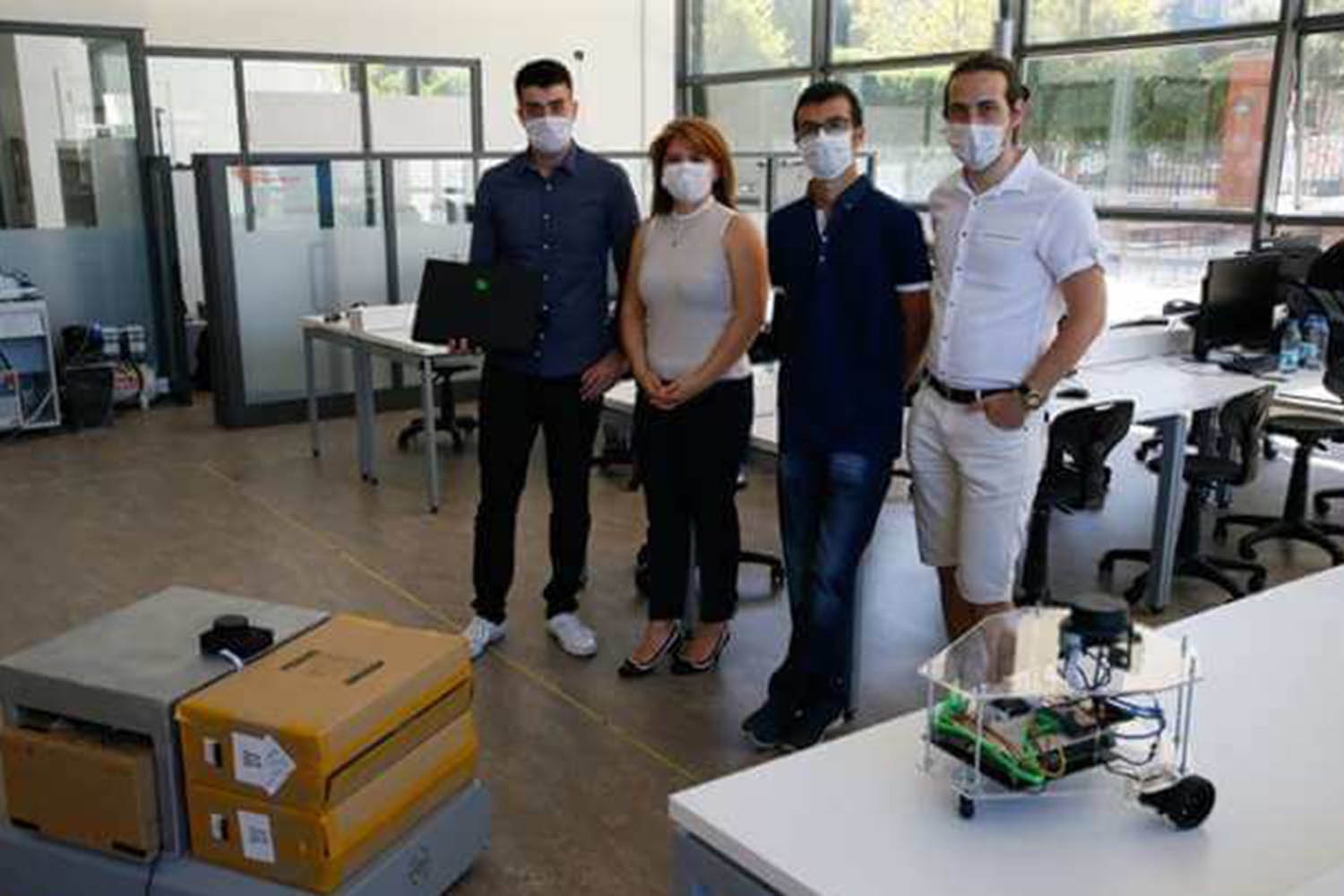
Self-routing autonomous robots by IUE engineers
An autonomous robot that can re-route using artificial intelligence, when it encounters an obstacle, has been developed with the project ...
| Course Name |
Creative Thinking
|
|
Code
|
Semester
|
Theory
(hour/week) |
Application/Lab
(hour/week) |
Local Credits
|
ECTS
|
|
GEIN 315
|
Fall/Spring
|
3
|
0
|
3
|
5
|
| Prerequisites |
None
|
|||||
| Course Language |
English
|
|||||
| Course Type |
Service Course
|
|||||
| Course Level |
First Cycle
|
|||||
| Mode of Delivery | - | |||||
| Teaching Methods and Techniques of the Course | Group WorkProblem SolvingApplication: Experiment / Laboratory / WorkshopLecture / Presentation | |||||
| National Occupation Classification | - | |||||
| Course Coordinator | ||||||
| Course Lecturer(s) | ||||||
| Assistant(s) | - | |||||
| Course Objectives | This course aims to harness and develop the innate creativity within each person using various methods, turning it into a powerful tool. It is designed to promote and develop creative thinking and problem-solving skills, addressing the need for individuals and teams to 'think outside the box' and applying fresh thinking to practical real-world problems. | |||||||||||||||||||||||||||||||||||||||||||||||||||||||||||||
| Learning Outcomes |
|
|||||||||||||||||||||||||||||||||||||||||||||||||||||||||||||
| Course Description | This course focuses on enhancing creative thinking and problem-solving skills. It starts with understanding the nature of creativity and the traits of creative individuals. Students will learn to overcome barriers to creativity and apply lateral thinking to complex problems. The course includes practical exercises, group discussions, and real-world projects to practice creative techniques. By the end of the course, students will have a toolkit of strategies to foster creativity and innovation in various contexts. | |||||||||||||||||||||||||||||||||||||||||||||||||||||||||||||
| Related Sustainable Development Goals |
|
|||||||||||||||||||||||||||||||||||||||||||||||||||||||||||||
|
|
Core Courses | |
| Major Area Courses | ||
| Supportive Courses | ||
| Media and Management Skills Courses | ||
| Transferable Skill Courses |
| Week | Subjects | Related Preparation | Learning Outcome |
| 1 | Principles of Creative Thinking | Mihaly Csikszentmihalyi - Creativity: The Psychology of Discovery and Invention, Chapter 2: Where is Creativity? ISBN0-06-092820-4 | |
| 2 | Overcoming Creative Blocks and Mindsets | ||
| 3 | Lateral Thinking | Edward De Bono - Six Thinking Hats, Chapter 6: The Purpose of Six Hat Thinking, 29-31, ISBN0-14-013784-X | |
| 4 | Idea Incubation and Generation | Bryan W. Mattimore, "Idea Stormers: How to Lead and Inspire Creative Breakthroughs" Chapter 2: Beyond Brainstorming: Understanding Individual and Group Ideation Techniques, 23-49 | |
| 5 | Challenging Assumptions | ||
| 6 | Interrogating Problems | Dan Roam, "The Back of the Napkin: Solving Problems and Selling Ideas with Pictures" Chapter 14: Why Should We Even Bother? 222-237 , ISBN 978-0-462-09947-7 | |
| 7 | Kickstarting Ideas | Chris Jarez-Brown - How to have kick-ass ideas Chapter 2: The Process, 51-75, ISBN 978-0-00-722094-6 | |
| 8 | Techniques and Approaches for Generating Ideas | Goldberg, Levav, Mazursky, Solomon : Cracking the Ad Code, Chapter 1: Unification, 18-41, ISBN 978-0-521-67597-0 | |
| 9 | Reflective Thinking | Donald A. Schön, "The Reflective Practitioner: How Professionals Think in Action", Chapter 1: Professional Knowledge and Reflection-in-action, ISBN 1-85742-319-4 | |
| 10 | Managing and Motivating Creative People | Bryan W. Mattimore, "Idea Stormers: How to Lead and Inspire Creative Breakthroughs" Chapter 1: A Map of the Creative Mind: Embracing Seven Creative Thinking Mind-Sets, 11-23 | |
| 11 | Practical Application of Creative Techniques | Goldberg, Levav, Mazursky, Solomon : Cracking the Ad Code, Chapter 2: Activation, 43-62, ISBN 978-0-521-67597-0 | |
| 12 | Group Work and Problem-Solving Sessions | ||
| 13 | Case Studies in Creative Thinking | "Harvard Business Review on Breakthrough Thinking" Chapter 2: Spark Innovation through Empathic Design, 29-57 Chapter 4: A Film Director’s Approach to Managing Creativity, 87-117 Chapter 7: Interpretive Management: What General Managers Can Learn from Design?, 161-189 ISBN 1-57851-181-X | |
| 14 | Final Project Presentation Preparation | ||
| 15 | Semester Review | Review of all course materials and preparation for the final exam. | |
| 16 | Final Exam | No additional materials required. |
| Course Notes/Textbooks | |
| Suggested Readings/Materials | Genrich Altschuller - Creativity as an exact science, 1984 Edward de Bono, "Lateral Thinking: Creativity Step by Step James L. Adams, "Conceptual Blockbusting: A Guide to Better Ideas” Tom Kelley and David Kelley, "Creative Confidence: Unleashing the Creative Potential Within Us All" John W. Gardner, "Self-Renewal: The Individual and the Innovative Society" Tina Seelig, "inGenius: A Crash Course on Creativity" Donald A. Schön, "The Reflective Practitioner: How Professionals Think in Action" Michael Michalko, "Thinkertoys: A Handbook of Creative-Thinking Techniques" |
| Semester Activities | Number | Weigthing | LO 1 | LO 2 | LO 3 | LO 4 | LO 5 | LO 6 |
| Participation |
1
|
10
|
||||||
| Laboratory / Application | ||||||||
| Field Work | ||||||||
| Quizzes / Studio Critiques | ||||||||
| Portfolio | ||||||||
| Homework / Assignments |
2
|
20
|
||||||
| Presentation / Jury |
1
|
20
|
||||||
| Project |
1
|
50
|
||||||
| Seminar / Workshop | ||||||||
| Oral Exams | ||||||||
| Midterm | ||||||||
| Final Exam | ||||||||
| Total |
| Weighting of Semester Activities on the Final Grade |
50
|
|
| Weighting of End-of-Semester Activities on the Final Grade |
50
|
|
| Total |
| Semester Activities | Number | Duration (Hours) | Workload |
|---|---|---|---|
| Theoretical Course Hours (Including exam week: 16 x total hours) |
16
|
3
|
48
|
| Laboratory / Application Hours (Including exam week: '.16.' x total hours) |
16
|
0
|
|
| Study Hours Out of Class |
14
|
3
|
42
|
| Field Work |
0
|
||
| Quizzes / Studio Critiques |
0
|
||
| Portfolio |
0
|
||
| Homework / Assignments |
2
|
15
|
30
|
| Presentation / Jury |
1
|
18
|
18
|
| Project |
1
|
30
|
30
|
| Seminar / Workshop |
0
|
||
| Oral Exam |
0
|
||
| Midterms |
0
|
||
| Final Exam |
0
|
||
| Total |
168
|
|
#
|
PC Sub | Program Competencies/Outcomes |
* Contribution Level
|
||||
|
1
|
2
|
3
|
4
|
5
|
|||
| 1 |
To have knowledge in Mathematics, science, physics knowledge based on mathematics; mathematics with multiple variables, differential equations, statistics, optimization and linear algebra; to be able to use theoretical and applied knowledge in complex engineering problems |
-
|
-
|
-
|
-
|
-
|
|
| 2 |
To be able to identify, define, formulate, and solve complex mechatronics engineering problems; to be able to select and apply appropriate analysis and modeling methods for this purpose. |
-
|
-
|
-
|
-
|
-
|
|
| 3 |
To be able to design a complex electromechanical system, process, device or product with sensor, actuator, control, hardware, and software to meet specific requirements under realistic constraints and conditions; to be able to apply modern design methods for this purpose. |
-
|
-
|
-
|
-
|
-
|
|
| 4 |
To be able to develop, select and use modern techniques and tools necessary for the analysis and solution of complex problems encountered in Mechatronics Engineering applications; to be able to use information technologies effectively. |
-
|
-
|
-
|
-
|
-
|
|
| 5 |
To be able to design, conduct experiments, collect data, analyze and interpret results for investigating Mechatronics Engineering problems. |
-
|
-
|
-
|
-
|
-
|
|
| 6 |
To be able to work effectively in Mechatronics Engineering disciplinary and multidisciplinary teams; to be able to work individually. |
-
|
-
|
-
|
-
|
-
|
|
| 7 |
To be able to communicate effectively in Turkish, both in oral and written forms; to be able to author and comprehend written reports, to be able to prepare design and implementation reports, to present effectively, to be able to give and receive clear and comprehensible instructions. |
-
|
-
|
-
|
-
|
-
|
|
| 8 |
To have knowledge about global and social impact of engineering practices on health, environment, and safety; to have knowledge about contemporary issues as they pertain to engineering; to be aware of the legal ramifications of engineering solutions. |
-
|
-
|
-
|
-
|
-
|
|
| 9 |
To be aware of ethical behavior, professional and ethical responsibility; information on standards used in engineering applications. |
-
|
-
|
-
|
-
|
-
|
|
| 10 |
To have knowledge about industrial practices such as project management, risk management and change management; to have awareness of entrepreneurship and innovation; to have knowledge about sustainable development. |
-
|
-
|
-
|
-
|
-
|
|
| 11 |
Using a foreign language, he collects information about Mechatronics Engineering and communicates with his colleagues. ("European Language Portfolio Global Scale", Level B1) |
-
|
-
|
-
|
-
|
-
|
|
| 12 |
To be able to use the second foreign language at intermediate level. |
-
|
-
|
-
|
-
|
-
|
|
| 13 |
To recognize the need for lifelong learning; to be able to access information; to be able to follow developments in science and technology; to be able to relate the knowledge accumulated throughout the human history to Mechatronics Engineering. |
-
|
-
|
-
|
-
|
-
|
|
*1 Lowest, 2 Low, 3 Average, 4 High, 5 Highest

An autonomous robot that can re-route using artificial intelligence, when it encounters an obstacle, has been developed with the project ...

As Izmir University of Economics transforms into a world-class university, it also raises successful young people with global competence.
More..Izmir University of Economics produces qualified knowledge and competent technologies.
More..Izmir University of Economics sees producing social benefit as its reason for existence.
More..